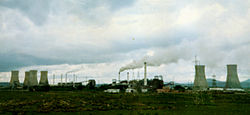7
1.17
New road
, rail or sea traffic
during construction or operation?
Yes
No rail or sea facilities are required.
Already roads are available to the
proposed project. Additional internal
roads required will be formed.
1.18
New road, rail, air, waterborne
or other
transport infrastructure
including new or altered routes
and stations, ports, airports etc?
Yes
As mentioned in the item 1.17
1.19
Closure or diversion of existing
transport routes or
infrastructure leading to
changes in traffic
mov
ements?
No
No Closure or diversions of existing
transport routes/infrastructure leading to
changes in traffic movements.
1.20
New or diverted transmission
lines or pipelines?
No
No New or diverted transmission
lines/pipelines
1.21
Impoundment, damming,
culverting, realignment or other
changes to the hydrology of
watercourses or aquifers?
No
No Impoundment, damming, culverting,
realignment or other changes to the
hydrology of watercourses/Aquifers.
1.22
Stream crossings?
No
No additional stream cross
ings in the
proposed expansion site.
1.23
Abstraction or transfers of water
from ground or surface waters?
Yes
Required water for the proposed unit will
be met from Godavari river near
Burgampadu through existing GRP pipe
link (approx. 26 km).
1.24
Chan
ges in water bodies or the
land surface affecting drainage or
run
-
off?
Yes
To a limited extent
1.25
Transport of personnel or materials
for construction, operation or
decommissioning?
Yes
Transportation is required for labour
from nearby villages and con
struction
materials for the project.
1.26
Long
-
term dismantling or
decommissioning or restoration
works?
No
No
Long
-
term
dismantling
or
decommissioning or restoration works.
1.27
Ongoing activity during
decommissioning which could
have an impact on the
e
nvironment?
No
Not envisaged
1.28
Influx of people to an area in
either temporarily or
permanently?
Yes
About 1000 labour during construction
will be employed. 100 Nos. of permanent
staff will work in the power plant during
operation stage.
1.29
In
troduction of alien species?
No
No Introduction of alien species
8
1.30
Loss of native species or genetic
diversity?
No
No loss of native species or genetic
diversity
1.31
Any other actions?
No
None
2)
Use of Natural resources for construction or ope
ration of the Project
(such as land,
water, materials or energy, especially any resources which are
non
-
renewable or in short supply)
Sl.
No
Information/Checklist
confirmation
Yes/
No
Details thereof (with approximate
quantities/rates w
herever possible) with
source of information data
2.1
Land especially undeveloped
or agricultural land (ha)
Yes
Existing vacant land will be used for the
main plant. Agricultural land for ash
pond.
2.2
Water (expected source &
competing users)
unit:
KLD
Yes
Water requirement is 48,000 KLD and
will be met from Godavari river
2.3
Minerals (MT)
Yes
Raw material is coal: 12023
TPD
2.4
Construction material
–
Cement, steel, stone,
aggregates, sand/soil
(expected source
–
MT)
Yes
Cement: 16,500 MT
S
tructural Steel : 7,700 MT
Reinforcement Steel : 4,950 MT
Stone/Aggregate: 0.55 lakh cum (local)
Sand : 0.33 lakh cum (local)
2.5
Forests and timber
(Source
–
MT)
No
Not applicable
2.6
Energy including electricity
& fuels (source, comp
eting
users)
Unit: Fuel (MT)
Energy (MW)
Yes
Electricity required will be met from the
existing station.
2.7
Any other natural resources
(use appropriate standard
units)
Yes
Oil (1 ml/kwh) for start up and flame
stabilization.
9
3)
Use, storage, transport, handling or production of substances or materials
which could be harmful to human health or the environment or raise concerns
about actual or perceived risks to human health
4)
Production
of
solid
wastes
during
constru
ction
or
operation
or
decommissioning (MT/month)
Sl.
No
Information/
Checklist confirmation
Yes/
No
Details thereof (with approximate
quantities/rates wherever possible) with
source of information data
4.1
Spoil, overburden or mine
wastes
Yes
Excavated soil during grading of the soil.
4.2
Ash/Municipal waste
(domestic and or
commercial wastes)
Yes
Ash generation: 4560
TPD(501 tph coal
with 38% ash)
Bottom Ash : 91
2
TPD
Fl
y ash: 36
48
TPD
Sl.
No
Information/
Checklist confirmation
Yes/
No
Details thereof (with approximate
Quantities/rates wherever possible) with
source of information data
3.1
Use of substances or materials,
which are hazardous (as per MSIHC
rules) to human health or
the
environment (flora, fauna, and water
supplies)
Yes
Furnace oil/HSD,
Chlorine, Alum, Caustic soda, HCL etc
will be used intermittently.
3.2
Changes in occurrence of disease
or affect disease vectors (e.g. insect
or water borne diseases)
No
No
Changes in occurrence of disease or
affect disease vectors.
3.3
Affect the welfare of people e.g. by
changing living conditions?
Yes
Improve living conditions of local people
3.4
Vulnerable groups of people who
could be affected by the project e.g.
hospital patients, children, the
elderly etc.,
No
The project is away from
Hospitals.
3.5
Any other causes
No
None
9
3)
Use, storage, transport, handling or production of substances or materials
which could be harmful to human health or the environment or raise concerns
about actual or perceived risks to human health
4)
Production
of
solid
wastes
during
constru
ction
or
operation
or
decommissioning (MT/month)
Sl.
No
Information/
Checklist confirmation
Yes/
No
Details thereof (with approximate
quantities/rates wherever possible) with
source of information data
4.1
Spoil, overburden or mine
wastes
Yes
Excavated soil during grading of the soil.
4.2
Ash/Municipal waste
(domestic and or
commercial wastes)
Yes
Ash generation: 4560
TPD(501 tph coal
with 38% ash)
Bottom Ash : 91
2
TPD
Fl
y ash: 36
48
TPD
9
3)
Use, storage, transport, handling or production of substances or materials
which could be harmful to human health or the environment or raise concerns






